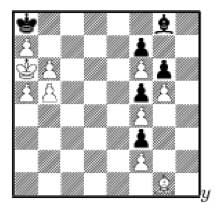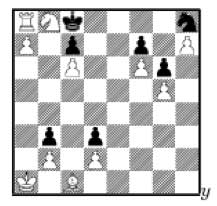Here is
a ‘difficult but not unsolvable’ Sudoku from David Eppstein‘s paper Nonrepetitive paths and cycles
in graphs with application to Sudoku.
$\begin{sudoku-block} |5| | | | |1| | |8|. | | | | | | |6| | |.
| | | | |6|2|5|7| |. | |9| |2| |5|1| | |. | | |4| |1| |3| | |. | |
|8|3| |9| |2| |. | |7|6|9|8| | | | |. | | |5| | | | | | |. |8| | |1|
| | | |3|. \end{sudoku-block}y1 $
As always I try to solve
Sudokus without having to use backtracking (that
is, making a guess and working from there on to a solution or a
contradiction in which case one uses the other option). Clearly, this is
not well defined. When one starts solving Sudokus one often resorts to
backtracking but after a while one discovers rules which seem to avoid
backtracking (but in a sense are still). For example, if two cells in a
same block (or row or column) can only be filled with two numbers one
can use this fact by forbidding other numbers to occupy those cells.
However, this is a mini-backtracking strategy. Still, I allow all such
rules. More precisely, any formal rule is non-backtracking in my
dictionary. In Eppstein’s paper there is a good summary of the rules
most people apply when starting a Sudoku. He calls them the ‘local
rules’. Here they are
- If a digit x has only one remaining
cell that it can be placed in, within some row, column, or square, then
we place it in that cell. Any potential positions of x incompatible with
that cell (because they lie in the same row, column, or square) are
removed from future consideration.
- If a cell has only one
digit x that can be placed in it, we place x in that cell. Incompatible
positions for x are removed from future consideration.
- If
some three cells, formed by intersecting a row or column with a square,
have three digits whose only remaining positions within that row,
column, or square are among those three cells, we prevent all other
digits from being placed there. We also remove positions for those three
forced digits outside the triple but within the row, column, or square
containing it.
- If the cells of a square that can contain a
digit x all lie in a single row or column, we eliminate positions for x
that are outside the square but inside that row or column. Similarly, if
the cells that can contain x within a row or column all lie in a single
square, we eliminate positions that are inside that square but outside
the row or column.
- If two digits x and y each share the same
two cells as the only locations they may be placed within some row,
column, or square, then all other digits must avoid those two cells.
- If the placement of digit x in cell y can not be extended to a
placement of nine copies of x covering each row and column of the grid
exactly once, we eliminate cell y from consideration as a placement for
x.
- If the placement of a digit x in cell y within a single
row, column, or square can not be extended to a complete solution of
that row, column, or square, then we eliminate that placement from
consideration.
But even if one manages to use all
these rules (and frankly I only use a subset) one might get stuck. I
don’t know how many cells you can fill in the above problem with these
local rules, I’m afraid I only managed $5 $… At such
moments, the bivalue Sudoku-graph may come in handy. Eppstein defines
this as follows
In this graph, we create a vertex
for each cell of the Sudoku grid that has not yet been filled in but for
which we have restricted the set of digits that can fill it to exactly
two digits. We connect two such vertices by an edge when the
corresponding two cells both lie in a single row, column, or square, and
can both be filled by the same digit; the label of the edge is the
digit they can both be filled by.
Eppstein then goes
on to define new rules (each of which is a mini-backtracking strategy)
which often help to crack the puzzle. Here are Eppstein’s ‘global
rules’
- If an edge in the bivalue graph belongs to a
nonrepetitive cycle, the digit labeling it must be placed at one of its
two endpoints, and can be ruled out as a potential value for any other
cell in the row, column, or square containing the edge.
- If
the bivalue graph has a cycle in which a single pair of consecutive
edges has a repeated label, that label can not be placed at the cell
shared by the two edges, so that cell must be filled by the other of its
two possible values.
- If the bivalue graph contains two
paths, both starting with the same label from the same cell, both
ending at cells in the same row, column, or square, and such that in the
two ending squares the values not occurring on the incident edge labels
are equal, then the cell at the start of the paths can not be filled by
the start label of the paths, and must be filled by the other of its two
possible values.
For example, in the above problem it
is not hard to verify that the indicated places X,Y and Z form a
nonrepetitive cycle in the bivalue graph so applying the first global
rule we have two choices of filling these places (one leading to a
solution, the other to a contradiction)
$\begin{sudoku-block} |5| | | | |1| | |8|. | | | | | | |6| | |.
| | | | |6|2|5|7| |. | |9| |2| |5|1| | |. | | |4| |1| |3| | |.
|X|Y|8|3| |9| |2|Z|. | |7|6|9|8| | | | |. | | |5| | | | | | |. |8| |
|1| | | | |3|. \end{sudoku-block}y2 $
In fact, it turns out
that making this choice is enough to solve the puzzle by simple local
rules. So, if I change the original puzzle by filling in the cell X
$\begin{sudoku-block} |5| | | | |1| | |8|. | | | | | | |6| | |.
| | | | |6|2|5|7| |. | |9| |2| |5|1| | |. | | |4| |1| |3| | |. |6|
|8|3| |9| |2| |. | |7|6|9|8| | | | |. | | |5| | | | | | |. |8| | |1|
| | | |3|. \end{sudoku-block}y3 $
you will have no problem
solving the puzzle.
 The problem is to give an infinite sequence
The problem is to give an infinite sequence